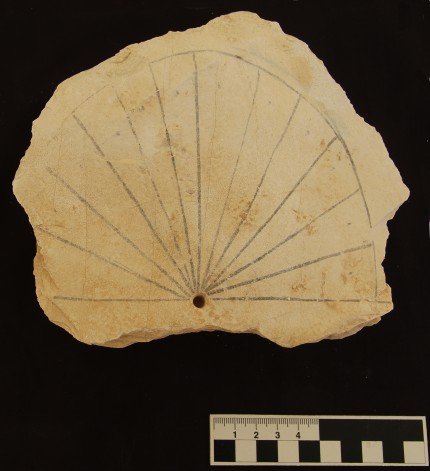A University of Basel archaeological team has discovered one of Egypt’s (and thus the world’s) oldest sundials in the Valley of the Kings. Excavators found the flat limestone piece when clearing the entrance to a tomb near a group of stone huts where workers building the tombs lived during construction. The huts date to the 13th century B.C., and researchers believe the sundial dates to the same period. It may even have been used by the workers to determine how much toiling they had left to do for the day.
It doesn’t look very fancy. The flat surface of the limestone is marked with a black semicircle divided into 12 segments marking what we call for the sake of convenience “hours” even though they didn’t have the fixed length that our hours have. Each section is approximately 15 degrees wide but they’re fairly roughly drawn. There’s a hole where the lines meet in the middle of the baseline which is where a tool — a wooden or metal rod — would be inserted to cast the time-keeping shadow over the limestone. Small dots have been added at the top middle of each segment to mark the half hour.
The 12 sections divide the daylight between sunrise and sunset. Obviously that period is shorter in the winter, so winter hours were shorter than summer hours. Until more precise clocks became widespread in the Renaissance, variable hours continued to be used in Europe.
As much as it looks like something intended more for the proletariat than the aristocracy, it’s entirely possible that the sundial could have come from the wall of a royal tomb.
The division of the sun path into hours also played a crucial role in the so-called netherworld guides that were drawn onto the walls of the royal tombs. These guides are illustrated texts that chronologically describe the nightly progression of the sun-god through the underworld. Thus, the sun dial could also have served to further visualize this phenomenon.

The oldest Egyptian shadow clocks date to around 1500 B.C. The earliest surviving sundial dates to the reign of Thutmosis III (1479 – 1425 B.C.) and is in the Egyptian Museum of Berlin. It’s an L-shaped stone engraved with the pharaoh’s name. On the short of the side of the L is a hole where a plumb bob would hang to do the shadowing while the long side is marked with five circles to tell the time. As far as we know, this is the oldest portable timepiece.
Turn of the century Egyptologists thought that Egyptian obelisks were used to tell time from the length and angle of their shadows, but recent scholarship disputes that theory. There is nothing in the copious engravings on their sides that has anything to do with time marking. The idea that they were massive timepieces is probably a result of their being used as sundials centuries later when they were looted and taken to Europe by the Romans and Napoleon’s troops.